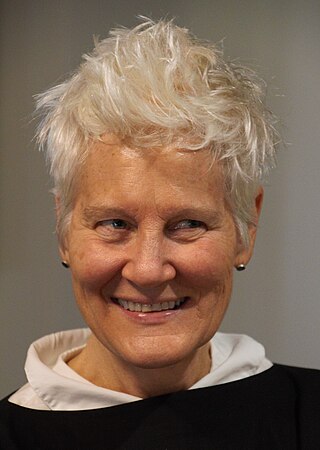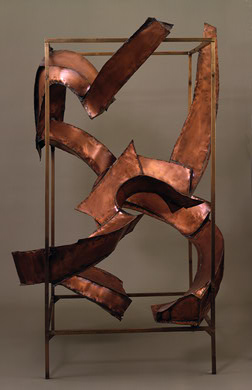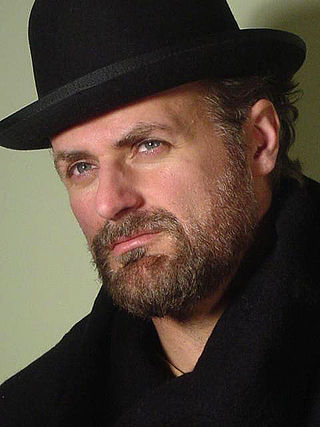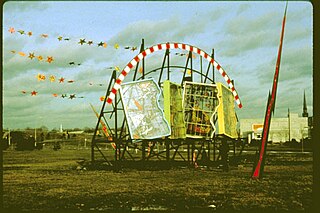
Bruce Nauman is an American artist. His practice spans a broad range of media including sculpture, photography, neon, video, drawing, printmaking, and performance. Nauman lives near Galisteo, New Mexico.
Lucy Skaer is a contemporary English artist who works with sculpture, film, painting, and drawing. Her work has been exhibited internationally. Skaer is a member of the Henry VIII’s Wives artist collective, and has exhibited a number of works with the group.

David Michael Wojnarowicz ( VOY-nə-ROH-vitch was an American painter, photographer, writer, filmmaker, performance artist, songwriter/recording artist, and AIDS activist prominent in the East Village art scene. He incorporated personal narratives influenced by his struggle with AIDS as well as his political activism in his art until his death from the disease in 1992.

Gary Hill is an American artist who lives and works in Seattle, Washington. Often viewed as one of the foundational artists in video art, based on the single-channel work and video- and sound-based installations of the 1970s and 1980s, he in fact began working in metal sculpture in the late 1960s. Today he is best known for internationally exhibited installations and performance art, concerned as much with innovative language as with technology, and for continuing work in a broad range of media. His longtime work with intermedia explores an array of issues ranging from the physicality of language, synesthesia and perceptual conundrums to ontological space and viewer interactivity. The recipient of many awards, his influential work has been exhibited in most major contemporary art museums worldwide.
Barbara Kruger is an American conceptual artist and collagist associated with the Pictures Generation. She is most known for her collage style that consists of black-and-white photographs, overlaid with declarative captions, stated in white-on-red Futura Bold Oblique or Helvetica Ultra Condensed text. The phrases in her works often include pronouns such as "you", "your", "I", "we", and "they", addressing cultural constructions of power, identity, consumerism, and sexuality. Kruger's artistic mediums include photography, sculpture, graphic design, architecture, as well as video and audio installations.

Tony Oursler is an American multimedia and installation artist. He completed a Bachelor of Fine Arts at the California Institute for the Arts, Valencia, California in 1979. His art covers a range of mediums, working with video, sculpture, installation, performance, and painting. The artist currently lives and works in New York City.

Walter Joseph De Maria was an American artist, sculptor, illustrator and composer, who lived and worked in New York City. Walter de Maria's artistic practice is connected with minimal art, conceptual art, and land art of the 1960s.

Ann Hamilton is a visual artist who emerged in the early 1980s known for her large-scale multimedia installations. After receiving her BFA in textile design from the University of Kansas in 1979, she lived in Banff, Alberta, and Montreal, Quebec, Canada before deciding to pursue an MFA in sculpture at Yale in 1983. From 1985 to 1991, she taught on the faculty of the University of California at Santa Barbara. Since 2001, Hamilton has served on the faculty of the Department of Art at the Ohio State University. She was appointed a Distinguished University Professor in 2011.
Christian Jankowski is a contemporary multimedia artist who largely works with video, installation and photography. He lives and works in Berlin and New York.

Jason Fayette Rhoades was an American installation artist. Better known in Europe, where he exhibited regularly for the last twelve years of his life, Rhoades was celebrated for his combination dinner party/exhibitions that feature violet neon signs with African, Caribbean, Creole and hip hop slang for the female genitalia.
Liz Phillips is an American artist specializing in sound art and interactive art. A pioneer in the development of interactive sound sculpture, Phillips' installations explore the possibilities of electronic sound in relation to living forms. Her work has been exhibited at a wide range of major museums, alternative spaces, festivals and other venues, including the Whitney Museum of American Art, the San Francisco Museum of Modern Art, the Spoleto Festival USA, the Walker Art Center, Ars Electronica, Jacob's Pillow, The Kitchen, and Creative Time. Phillips' collaborations include pieces with Nam June Paik and the Merce Cunningham Dance Company, and her work has been presented by the Cleveland Orchestra, IBM, and the World Financial Center. She is often associated with, and exhibited alongside other early American sound artists Pauline Oliveros, John Cage and Max Neuhaus.

Herbert Ferber was an American Abstract Expressionist, sculptor and painter, and a "driving force of the New York School."

John LeKay is an English conceptual and installation artist and sculptor, who lives in New York City. In 1993, he began to make skulls covered in crystal: he has accused Damien Hirst of copying this and other ideas. He publishes the web site, heyokamagazine.

Chryssa Vardea-Mavromichali was a Greek American artist who worked in a wide variety of media. An American art pioneer in light art and luminist sculpture, known for her neon, steel, aluminum and acrylic glass installations, she always used the mononym Chryssa professionally. She worked from the mid-1950s in New York City studios and worked since 1992 in the studio she established in Neos Kosmos, Athens, Greece.

Green Lightning is a sculpture created by artist Billie Lawless. An original maquette was created for ArtPark in the fall of 1983, and the sculpture was dedicated in Buffalo, New York in November 1984.
Marshall Arisman was an American illustrator, painter, storyteller, and educator.
Nancy Dwyer is an American contemporary artist whose works include paintings, works on paper, public art, word sculpture and furniture art. Her work has been exhibited widely at venues including the Whitney Museum of American Art, the Museum of Contemporary Art, Los Angeles, the Contemporary Arts Museum in Houston, the New Museum in New York and many others. Her work was included in the 2009 exhibition “The Pictures Generation” at the Metropolitan Museum of Art in New York, alongside the work of her peers and contemporaries, including Cindy Sherman and Robert Longo, with whom she cofounded Hallwalls in Buffalo, New York in 1974, as well as work by Barbara Kruger, Richard Prince, John Baldessari, Louise Lawler and Sherrie Levine, among others.

Patsy Ann Norvell (1942–2013) was an American visual artist who worked in sculpture, installation art and public art. She was a pioneering feminist artist active in the Women's movement since 1969. In 1972 she was a founder of A.I.R. Gallery which was the first cooperative gallery in the U.S. that showed solely women's work. Her work has been exhibited in galleries and museums in the U.S. and abroad. She received numerous grants, awards and residencies for her achievements, including the Pollock-Krasner Foundation and the National Endowment for the Arts. She created permanent public art works for the New York City subway system, designed and created lobby and plaza installations in Los Angeles, CA, New Brunswick, NJ, Bridgeport, CT, and Bethesda, MD. Her work has received historical and critical acclaim, and has been written about in books, journals and newspapers including, Art in the Land: A Critical Anthology of Environmental Art, in Sculpture (magazine), the Los Angeles Times, The New York Times and numerous other publications.
Sondra Perry is an interdisciplinary artist who works with video, computer-based media, installation, and performance. Perry's work investigates "blackness, black femininity, African American heritage" and the portrayal or representation of black people throughout history, focusing on how blackness influences technology and image making. Perry explores the duality of intelligence and seductiveness in the contexts of black family heritage, black history, and black femininity. "Perry is committed to net neutrality and ideas of collective production and action, using open source software to edit her work and leasing it digitally for use in galleries and classrooms, while also making all her videos available for free online. This principle of open access in Perry's practice aims to privilege black life, to democratize access to art and culture, and to offer a critical platform that differentiates itself from the portrayal of blackness in the media". For Perry, blackness is a technology which creates fissures in systems of surveillance and control and thus creates inefficiency as an opportunity for resistance.

Esperanza Cortés is a Colombian-born American visual artist who lives and works in New York City. Her paintings, sculptures and installations explore the themes of social injustice and cultural invisibility. She draws on the folk traditions of the Americas, including their rituals, music, dance and art.






















